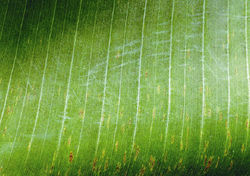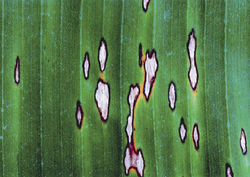Pseudocercospora musae
| Literature database |
|---|
| 35 articles sorted by: |
| • year (recent ones first) |
| • research topics |
| • countries/regions |
| • host plants |

Source: PaDIL

Source: PaDIL
Pseudocercospora musae (Zimm. 1902) Deighton 1976 - (yellow Sigatoka)
The fungus causes the yellow Sigatoka disease, also called banana leaf spot. It has been first recorded on the Indonesian island of Java in 1902 and is now widely distributed in the banana growing regions around the world. The symptoms start with small elongated pale yellowish streaks on the upper leaf surface, about 1-2 mm long. These enlarge and fuse causing necrotic spots. Yield losses can reach 50% and the fungus can produce mycotoxins. The disease is mainly managed by fungicide applications and planting resistant cultivars.
P. musae is part by the Sigatoka disease complex which also includes the black Sigatoka disease (Pseudocercospora fijiensis) and the eumusae leaf spot disease (Pseudocercospora eumusae). All three fungal species are similar morphologically, cause similar symptoms and have bananas and other Musa species as hosts. However, there are clear differences in their virulence with P. fijiensis being the most aggressive and P. musae the least virulent one. Since the 1960's, the widely distributed P. musae has been gradually replaced by P. fijiensis.
Synonyms:
Cercospora musae
Mycosphaerella musicola
| Vernacular names | |
|---|---|
| • Deutsch: | Sigatoka-Krankheit der Banane |
| • English: | yellow Sigatoka disease banana leaf spot |
| • Français: | cercosporiose du bananier |
| • Português: | Sigatoka-amarela |